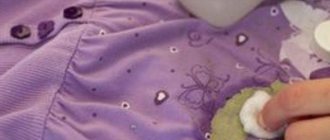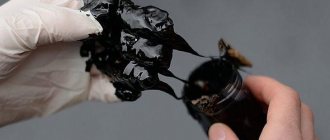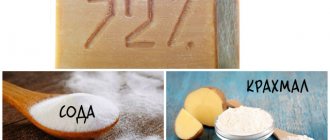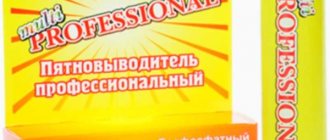Anyone can get resin on their hands, so it’s important to know how to get rid of it as quickly as possible. Such a situation is unlikely to be pleasant for anyone, but you should not fall into despair, because you can cope with this problem with a little effort and a few useful minutes. To remove tar and return the skin to an attractive appearance, you can use various traditional methods. All you have to do is choose an acceptable option and start acting.
What to do if resin gets on your skin
The first rule is don't panic.
Epoxy glue, although it is a complex two-component material, is in fact not dangerous if it does not interact with the skin for a long time. Let us now consider several methods that are guaranteed to remove epoxy resin from your hands.
The resin cannot cause extensive lesions or skin infections. But acute pain is guaranteed. In addition, burns are possible when working with heated material.
Therefore, in case of contact with skin, the resin should be removed using any cloth. And the remaining thinner layer must be removed with alcohol or any solvent.
As mentioned earlier, when working with chemicals, you must wear protective clothing.
But if restoration work is delayed, for example, when gluing a rubber boat, then latex gloves can easily tear and allow the product to reach the skin of the hands. In this case, you need to take the following steps.
- Remove the gloves from your hands immediately and discard them; you will no longer need them.
- Wash your hands immediately with laundry or tar soap.
- After the bulk of the product has been washed off, it is necessary to dissolve the remaining stains of the product on the skin. For cleaning, you can choose acetone, nail polish remover, denatured alcohol, etc. Soak a cotton swab in the liquid and carefully wipe the glue off your hands.
- After a positive result, wash your hands again with baby soap that has a softening effect.
- Solvents are no less harmful to the delicate skin of your hands; they evaporate moisture from the cells. Therefore, upon completion of cleansing, you should apply a rich nourishing cream to the skin of your hands: baby cream, olive cream.
Precautionary measures
Professional resin solvents are harmful to health. Therefore, wear a mask, goggles and gloves when using. The process itself is best carried out on the street; here the owners of their home and the area near it benefit. In addition to being toxic, the fumes are easily ignited by the smallest spark.
Don’t get carried away with efficiency and remember minimalism; in this case, this approach is especially relevant. Apply only a small amount and follow the instructions carefully. Place processed items so that children cannot reach them.
Professionalism does not guarantee results. Moreover, the products can even be harmful, especially to delicate materials. Before removing pine resin from clothing, test the reaction on an invisible area. Apply just a little of the drug and watch the tissue reaction.
Where are resin contaminations most often located?
The most common way to use epoxy resin is as an adhesive. Epoxy glue is an old proven tool for repairing rubber products, shoes, gluing wooden and ceramic surfaces.
In domestic conditions, glue most often gets on unprotected areas of the skin of the hands, as well as on items of clothing. Therefore, it is strongly recommended to work with glue wearing protective gloves and an apron.
If the substance does get on the skin, it is necessary to take immediate action, since synthetic resin is an aggressive chemical and can cause burns to the epidermis, dermatitis, and allergic reactions.
How to get pine nuts from cones
Cedar is a fairly rare plant, so buyers usually see expensive nuts already in a shelled state. However, if you manage to get a cone, it doesn’t hurt to familiarize yourself with the information on how to properly remove the seeds from it. At this stage, it is better to use gloves so as not to have to look for a way to wash the resin from the skin of your hands later. If the cones are ripe, then you won’t have to make much effort. Just tap it on the side of the pan and some of the fruit will fall out on its own.
But the option described above, which involves heat treatment of the cones, is preferable. Firstly, all the resin will be removed immediately, and secondly, after this you will not have to further process the nuts themselves to soften the shells. After cooking, it will become thin and easy to remove.
Once the pine cone is cleaned and the nuts are collected, you need to remove the shell to get to the tasty kernel. This can be done using available household tools. Additional processing to soften the shell will help make your work easier.
Removing epoxy resin from hands using Coca-Cola
In this case, Coca-Cola helps not only boil the kettle, but also remove epoxy from your hands. In fact, in addition to the famous cola, Fanta, Sprite, Pepsi and other similar drinks are suitable.
How to prepare a mixture for removing epoxy from hands:
- For 1 liter of Cola, take 1 tbsp. spoon of soda
- Shake Stir
- Wash your hands in the solution
- The duration of washing is no longer than 10 minutes
- Rinse off with plain water
- Wash your hands again with soap and apply baby cream
Dried resin on hands - how to wash it off?
Renovation work is very exciting, especially for hardworking men. And often resin stains on the skin of the hands are found already in a hardened form, which can be tried to be washed off in several ways.
- Ice cubes. If you are at home, you can use a cube or piece of ice from the freezer. Rub the dirt vigorously with ice and wait. Under the influence of cold, the glue will dry quickly, and it can be carefully removed from your hands, for example, with the blunt side of a knife.
- Oily liquids. Spread the resin stain with a thick layer of oil: sunflower, olive, cosmetic. As an option, high-fat mayonnaise is sometimes used. Periodically rub the oily substance into the epoxy stain. Then you can try to remove the softened resin from the skin with gentle movements.
- Solvent. Both for hardened stains and for fresh smears of glue, a solvent or various alcohols are used: denatured alcohol, wine alcohol, ammonia, etc.
The question of how to wash off epoxy resin that gets on the skin is far from idle. Not all solvents are used to remove chemicals from hands. Some leave burns, others cause allergens that can trigger eczema. Allergy sufferers should be especially careful when using chemicals.
Be sure to read:
We suggest you read: How to clean an automatic washing machine with vinegar to remove scale and unpleasant odors?
How to dissolve silicone: effective ways to remove sealant from various surfaces
Those who are not afraid of allergic reactions can wash off the epoxy with a swab soaked in 646 solvent or acetone. You can wipe your hands with these substances to remove residual resin from them. Hands are immediately washed with soap and lubricated with protective cream. Before starting to work with epoxy, it is recommended to lubricate the skin of your hands with a protective cream and wear gloves.
Mechanical removal
To remove sagging from the surface of the boards, you must first wait until they harden. The frozen mass is removed using a sharp object . A knife, spatula, or scalpel are suitable for this. When all drops have been removed, the board is polished with sandpaper or a sanding tool.
In some cases, it makes sense to drill out large resinous areas in the area of knots with a milling tool or cut out with a knife. The resulting recesses are filled with putty or a wooden chopstick is inserted onto the glue. Then the board is sanded.
If localized lesions are left, they will be a constant source of sticky droplets in the future. The release of resin on softwood boards increases when heated.
Removing epoxy stains from hands using baking soda
Soda is a fairly common reagent that we often use in our households and everyday life. The main advantage of soda is that even if it comes into contact with the skin for a long time, there will be no burn. The main rule when using soda is to not let your hands and surfaces dry out.
How to prepare a mixture for removing resin using soda:
- Prepare a solution in the proportion of 1 tbsp. spoon of water
- Add to this 3 teaspoons of soda
- Make a paste from the resulting mixture
- Carefully apply the paste to the contact site and the resin itself.
- Removing epoxy resin
- Wash off the mixture with warm water
Removing old stains
How to remove resin from clothes if the stain is old? On the one hand, time intensifies the problem itself, but on the other hand, there is a way out in this case. In this case, both folk and chemical remedies can also be used. In difficult situations, you can combine them by stocking up on vegetable fat and washing powders.
Important:
Standard cleaning
If the stains are on ordinary fabric (linen, cotton, cotton, etc.), more aggressive cleaning agents may be suitable for cleaning. First of all, you can try to moisten the old dirt with sunflower oil and leave it like that for three to five hours. After this treatment, the resin will soften and the immediate removal procedure can begin.
If the tree resin has become soft enough, you can try cleaning it with a knife or scraper. If after the procedure particles of a sticky substance still remain, you can additionally treat the fabric with turpentine, and then wash it with powder
It is important to remember that turpentine can leave ingrained stains, so it is not recommended for use on light-colored fabrics.
The following recipe can help in removing stains:
- It is necessary to mix white clay and potato starch in equal quantities (the volume depends on the amount of contamination);
- Pour in a small amount of turpentine (until the consistency of thick sour cream);
- Add three to four drops of ammonia;
- Mix.
The resulting composition is applied to the material until completely dry, after which it is removed with a brush with coarse bristles (you can use a metal sponge) along with the resin. If the resulting product does not remove the stain the first time, the process can be repeated.
The detergent composition can be effective without adding clay.
Important:
The second recipe that answers the question “How to remove resin?” may be no less effective, but more expensive. For the product you will need:
- Fifteen grams of gasoline;
- One hundred grams of wine alcohol;
- Thirty-five grams of ammonia.
All this must be mixed and applied to the products until completely dissolved. Store-bought white spirit can give the same effect. After pre-cleaning, you can do a regular wash in a machine drum or by hand.
How to remove pine resin using chloroform paste? Chloroform is spread on the stain until it softens, after which it is removed with the resin using soap. Next, the items can be washed as standard.
The method of cleaning clothes using a household iron can be considered effective, since the resin is easily destroyed by temperature. One or two paper napkins are applied to the stained area on both sides, after which the product must be carefully ironed in the usual way. The softened sticky substance will be partially or completely absorbed into the wipes. You can enhance the effect by moistening the stain with turpentine or a mixture of turpentine and alcohol. The method can be combined with others.
If the resin is sufficiently dry and cannot be transferred to other clothes, the items can be washed several times in the washing machine with regular powder. With each wash, the dirt will become less and less and will eventually be completely destroyed.
Cleaning delicate fabrics
Many mechanical and chemical cleaning methods for medium and coarse fabrics are not suitable for washing delicate items. One of the most gentle methods involves wetting the stains with vegetable oil and then treating the fabric with an effective dishwashing detergent (which easily removes grease). This technique is suitable for washing silk and woolen items.
You can use hot soapy water to remove tar from leather products after applying vegetable oil to them. It is not recommended to apply oil to suede and velor. In the case of them, it is best to use medical (or any other) alcohol and a brush. If resin has damaged your fur items, alcohol will also help clean it.
To remove dirt from velor, silk fabrics and velvet, you can use the following recipe: mix starch, turpentine and ethyl alcohol in a ratio of 2:1:1 and place the resulting paste on the resin. After twelve hours, items can be washed in the usual way, rinsing off the composition in clean water.
If the stain was applied to a delicate fabric, but there were no suitable chemicals at hand, alcohol or vodka alone will be enough.
Non-standard methods for cleaning clothes
You can remove a thin layer of resin from clothing using solvents.
There is no need to try to immediately wipe off fresh resin from clothes - this will spread it over the surface and go even deeper into the threads. You should not wash the item in the machine or rub the stain with laundry soap - this will only worsen the situation. The main difficulty in removing resin stains from fabric is that the resin, which enters the material in liquid form, impregnates it and hardens into the fibers. Removal must be carried out in stages: first, surface contamination is removed, then the internal structure of the threads is cleaned.
Before removing the resin stain, the fabric should be placed in the refrigerator freezer for two hours. The frozen substance is then carefully scraped off the surface of the clothing. Stains on large items that do not fit in the freezer are covered with ice cubes for freezing. However, traces of resin on things made of thin fabric cannot be removed using this method - they can be damaged by scraping.
The second stage consists of using solvents, since it will not be possible to remove stains from the resin of pine and other coniferous trees from fabric without their help. You can clean the material with gasoline, white spirit or turpentine, in which you need to moisten a foam sponge. Pure alcohol or vodka also cleans resin well.
The resin poses the greatest danger to woven materials. These are a variety of jeans, trousers, shirts and so on. If resin gets on such a surface, you must proceed according to the following algorithm:
- The corresponding item of clothing must be placed in the freezer. Low temperature will prevent the diffusion process. That is, resin particles will not be able to penetrate deeply into the fabric. Accordingly, curing will occur on the surface of the garment without affecting the structure of the material. Keep clothes in the freezer for no more than 10 minutes. Prolonged exposure to low temperatures will not improve the result. Therefore, 10 minutes will be enough;
- Then, you need to use a thin metal knife to remove the resin from the surface of the stained object. It is necessary to “pick off” the resin without damaging the fabric itself. To do this, it is advisable to stretch the fabric so that the entire surface of the stain is accessible;
- Typically, there will be a stain where the resin was. It will not be very noticeable if you freeze the clothes in a timely manner. If the resin has managed to penetrate inside the fabric, then the contamination will be more pronounced. To get rid of this stain, you should use alcohol. You need to soak a cotton swab or napkin generously with alcohol. After which, you need to treat the remaining stain.
This method has been carried out repeatedly and is the most effective. In this way I cleaned a stain of epoxy resin with a diameter of 5 cm. I must say that after freezing and alcohol treatment there was absolutely no trace left of the stain.
Frozen clumps of resin on good clothes are an unpleasant phenomenon, but also completely removable.
Advice! Large pieces of dirt must first be mechanically scraped off with a knife or a thin file. This method is applicable only for rough work clothes: overalls, denim trousers, aprons.
Finer fabrics should be cleaned delicately and carefully. You can remove stains at home using well-known products. For best results, glue stains must be frozen. We place the clothes in the freezer for two to three hours, the cleansing process will go faster and more efficiently.
- Alcohols. Wine, ammonia, and denatured alcohol are excellent means for resuscitating your favorite clothes. We moisten a piece of clean rag or a cotton-gauze swab in alcohol and begin to clean the dirty stains. As a rule, with some effort, it is quite possible to achieve complete victory over the dirt.
- Turpentine. Natural pine extract has a good cleansing effect. For fabrics, it is better to choose pharmaceutical gum turpentine rather than technical turpentine. Apply generously to the stain and leave it on the clothing material for a while. Take a soft brush and scrub the stain. Turpentine has a sharp, characteristic odor, which can be eliminated by subsequent washing in the machine with aromatic powder and conditioner. For stubborn stains, use a solution of turpentine and alcohol mixed in equal parts.
- Melting. Epoxy can both harden and liquefy. For this purpose, a heating method is used. For fabric, ironing stains with a hot iron works well. Lay the material out on an ironing board and place a piece of clean plain fabric or a paper towel on both sides under the stains. With intensive ironing, the glue will gradually melt and be absorbed into the substrate. After the procedure, light stains should also be rubbed with alcohol to consolidate the effect. The final stage of cleaning will be automatic washing of clothes on a standard cycle.
- Store-bought stain removers. Some types of stain removers are very successful at removing even stubborn stains such as epoxy glue. Stains from white clothing should be washed with oxygen-containing bleaches. Soak a white item in warm water, add bleach and leave for 1-2 hours to act. Yellowish stains on the fabric after soaking will disappear when washed in an automatic machine.
- Solvents. Silk and synthetic fabrics lend themselves well to cleaning with a range of solvents. Printed fabrics can be cleaned with nail polish remover; it is less aggressive to fibers and patterns. For difficult to remove stains from plain clothes, white spirit or acetone are more suitable.
We suggest you read How to remove glue from adhesive fabric
As practice shows, non-trivial ways to save wardrobe items dear to your heart also work.
For example, the well-known brands of carbonated drinks “Coca-Cola” and “Pepsi-Cola” have proven themselves well as a powerful household cleaner.
Of course, there is no need to add lemonade to the washing machine, but it is quite possible to mechanically remove stains from colored fabrics. After the obvious cleaning effect, it is better to wash the item thoroughly.
Dimexide is a cheap pharmaceutical product for treating postoperative sutures and compresses. Dimexide should be diluted in warm water in approximately a ratio of 1:3, wet the fabric generously with the solution, leave for a while, and then wash in the usual way.
Chemical solvents
An excellent solvent is alcohol, which destroys and dissolves many adhesive compounds. After applying alcohol to the glue spot, after a few minutes it will begin to soften. After this, the remaining glue can be easily removed with water and a rag. Acetone has a similar effect, which must be moistened with a cotton swab and placed on the spot. After a few minutes, the glue will dissolve and you can wipe it off with an old toothbrush. Acetone should be used with caution on some synthetic materials, as it can damage them. Substances such as gasoline, turpentine, white spirit, and paint thinner are also excellent at dissolving glue. or ammonia. They are used in the same way as acetone, however, to simplify removal, the glue can be softened with the help of a hairdryer turned on before applying the solvent. After this, it will dissolve much faster and more readily, and finally the stain can be carefully scraped off with a convenient object at hand.
Today, along with medications, folk remedies are widely used, which in their composition and the presence of side effects are no longer dangerous. The use of coniferous tree resin is of great interest in medical practice.
Removing Epoxy from Hands Using Rubber Glue
It may be surprising for some that the glue should be removed with glue, but there is another side to the issue. The essence is not a wedge with a wedge, but in some ways there is a similar meaning. The fact is that rubber glue contains solvents, but the main thing here is not to overexpose it.
The entire removal operation should not take 10 seconds, otherwise you will also have to remove rubber glue from your hands later.
What to do with rubber glue
- Apply glue to the skin area
- Keep the glue on contact for no longer than 10 seconds
- Gently roll the glue and resin from the contaminated area with your fingers.
- Wash your hands with soap and apply baby cream
We buy regular gum turpentine. This product is completely safe for the skin and does not cause any reaction that will harm it.
Preparing a mixture for removing turpentine starch ammonia
- Add 3 drops of ammonia to the prepared container.
- Add 1 tbsp. a spoonful of starch
- Add 4 drops of turpentine to the mixture
- Mix everything thoroughly
- Apply to the contaminated area
- Removing epoxy stain using a hand brush
- Wash everything thoroughly with laundry soap and apply baby cream.
Everything here is simple to the point of banality. Acetone is found in almost every home, and every woman is familiar with its smell when she washes off nail polish.
How to remove epoxy resin with acetone
- Apply acetone to a cotton pad
- Apply the cotton pad to the epoxy stain for 3-5 seconds
- After that, try to clean the stain
- After cleansing, wash your hands with soap and apply baby cream
Well, that’s all, we hope these methods will be useful and simple for you, since these materials and reagents are available in almost every home and you will certainly find a suitable method for yourself.
We suggest you read: How to clean a comb with natural bristles: how to clean a brush (comb) with natural bristles?
Pre-cleaning
You won’t be able to wash it with water or wipe the resin off your clothes. Here we need radically different approaches. Some stains become easier to remove when heated, but not in this case. As the temperature rises, the resin will become even more sticky and may spread over a larger surface.
Low temperatures will help remove tree resin. If frozen, it loses its adhesive properties and falls off with little effort. Therefore, take the item out into the cold and leave it until it freezes completely; in the summer you can put it in the freezer for an hour. After freezing, put on gloves before starting to work to avoid sticking to your fingers. Dirty hands can only make the situation worse. A small piece of resin can be easily removed from clothing. But if the contamination is serious, or only a trace of it remains, other approaches are needed.
When removing unfrozen resin, you must act very carefully so that dirt does not enter the fabric structure. Delicate materials such as suede will not tolerate this method at all.
Freezing can quickly and permanently ruin an item. It is better to use improvised or special means that corrode and dissolve the resin.











